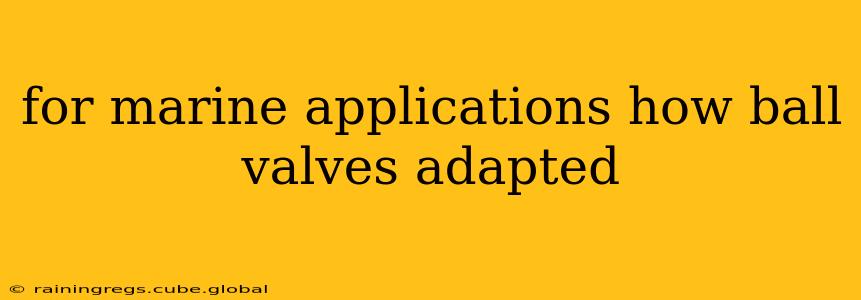Marine environments present unique and formidable challenges for any piece of equipment. Saltwater corrosion, extreme temperatures, pressure fluctuations, and constant motion all demand robust design and materials. Ball valves, known for their simple design and reliable operation, have been successfully adapted for marine applications through several key modifications. This article will explore these adaptations, addressing common questions surrounding their use in the maritime industry.
What Makes Marine Ball Valves Different?
Standard ball valves often lack the durability and corrosion resistance needed for marine applications. Marine ball valves are specifically engineered to withstand the harsh conditions at sea. Key differences include:
- Materials: Instead of standard brass or steel, marine ball valves often utilize materials like stainless steel (316 grade is common), bronze, or even specialized alloys like duplex stainless steel. These materials offer superior corrosion resistance to saltwater and other marine contaminants.
- Sealing: The seals are critical. Marine ball valves utilize high-performance elastomers, like EPDM or Viton, which are resistant to degradation from UV radiation, saltwater, and chemicals often found in marine environments. These seals need to maintain their integrity under significant pressure and temperature variations.
- Coatings: Some marine ball valves feature specialized coatings, such as epoxy or polyurethane, to further enhance corrosion protection and longevity.
- Design: The design itself is often reinforced to withstand the stresses of wave action, vessel movement, and potential impacts. This might involve thicker walls, reinforced stems, or specialized body geometries.
What are the Key Applications of Marine Ball Valves?
Marine ball valves find applications across numerous systems on vessels of all sizes:
- Bilge Systems: Controlling the flow of water from bilges.
- Ballast Systems: Managing the intake and discharge of ballast water.
- Fire Fighting Systems: Controlling the flow of water and fire-suppressing agents.
- Hydraulic Systems: Used in various hydraulic systems onboard.
- Fuel and Lubrication Systems: Controlling the flow of fuel and lubricating oils.
- Seawater Systems: Used for cooling, intake, and other seawater-related operations.
- Wastewater Systems: Controlling the flow in sewage and other wastewater systems.
What Types of Seals are Used in Marine Ball Valves?
The choice of seal material is crucial for marine ball valves. Common seal materials include:
- EPDM (Ethylene Propylene Diene Monomer): Offers good resistance to saltwater, ozone, and many chemicals.
- Viton (Fluoroelastomer): Provides excellent resistance to a broader range of chemicals, high temperatures, and pressures. It's often preferred for high-performance applications.
How Do Marine Ball Valves Handle High Pressure?
Marine ball valves designed for high-pressure applications utilize reinforced bodies and stems, along with high-quality seals capable of withstanding the pressure demands. The specific pressure rating will vary depending on the valve's design and material. Always check the manufacturer's specifications to ensure suitability for the intended application.
What are the Maintenance Requirements for Marine Ball Valves?
Regular maintenance is essential to ensure the continued reliable operation of marine ball valves. This typically includes:
- Visual Inspections: Regularly checking for corrosion, leaks, or damage.
- Lubrication: Periodic lubrication of the stem to prevent seizing.
- Seal Replacement: Replacing seals as needed, depending on the valve's usage and the environment.
How to Choose the Right Marine Ball Valve?
Selecting the appropriate marine ball valve requires careful consideration of several factors:
- Pressure Rating: Ensure the valve can handle the maximum pressure it will experience.
- Temperature Rating: The valve must be able to withstand the expected temperature range.
- Material Compatibility: Choose materials resistant to the specific fluids and environment.
- Size and Connections: Select the correct size and connection type to match the piping system.
- Flow Characteristics: Consider the required flow rate and pressure drop.
Proper selection and maintenance of marine ball valves are crucial for the safe and efficient operation of any vessel. Choosing valves designed specifically for marine applications, with appropriate materials and seals, ensures reliable performance in the demanding marine environment. Always consult with a qualified marine engineer or valve specialist for critical applications.
